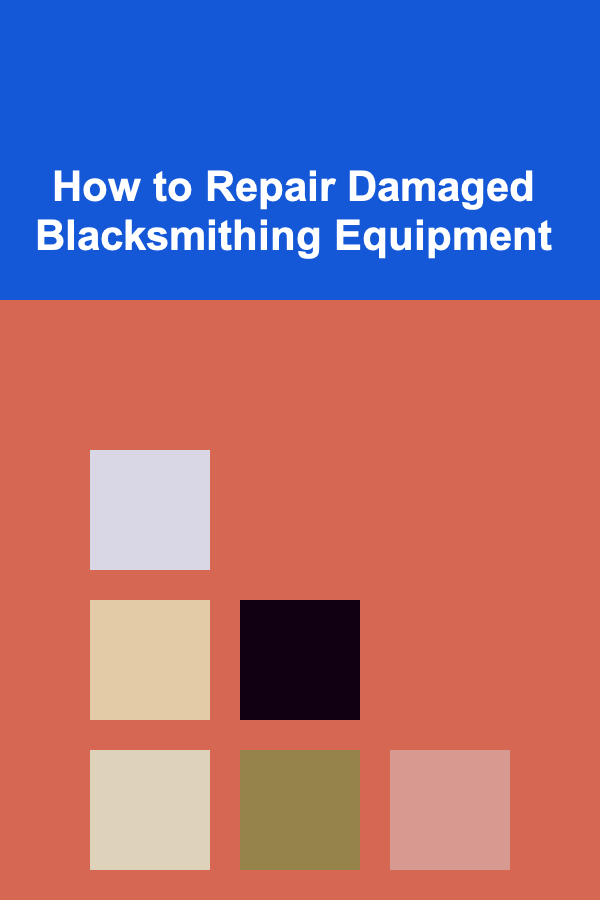
How to Repair Damaged Blacksmithing Equipment
ebook include PDF & Audio bundle (Micro Guide)
$12.99$5.99
Limited Time Offer! Order within the next:

Blacksmithing is an age-old craft, blending artistry and practical skill to shape metal into functional and decorative objects. The tools used in blacksmithing, such as hammers, anvils, tongs, and forges, are often subjected to intense heat, stress, and wear. Over time, it is inevitable that some equipment may become damaged or worn out, which can disrupt the workflow and even halt projects entirely. Knowing how to repair and maintain blacksmithing tools is an essential skill for every blacksmith, ensuring the longevity of the equipment and maintaining an efficient workspace.
In this article, we will explore the various types of damage that can occur to blacksmithing equipment and provide detailed instructions on how to repair or restore these tools to their former glory. We will cover common tools such as anvils, hammers, tongs, chisels, and forges, as well as methods for sharpening, welding, reconditioning, and proper care.
Repairing Anvils
Anvils are one of the most crucial tools in a blacksmith's shop, used for shaping metal by hammering it over a hard surface. Due to their critical role and the heavy-duty tasks they are subjected to, anvils can suffer from damage over time, including cracks, chips, and excessive wear. Fortunately, repairing anvils is often possible, though it may require professional expertise depending on the extent of the damage.
Common Issues and Solutions:
1.1 Cracks in the Face or Body
Cracks in the face of an anvil, especially those that run deep, can significantly reduce its usefulness. Cracks may develop due to years of heavy use or improper handling, such as dropping the anvil or using it incorrectly.
Repair Process:
- Inspect the Crack: Determine the depth and width of the crack. If the crack is minor and superficial, it may not affect the functionality of the anvil significantly.
- Welding: For deeper cracks, you may need to use a high-quality welding machine to repair the crack. Arc welding is often used to weld cracks on steel anvils. However, this requires skill and proper heat control to prevent further damage to the anvil.
- Heat Treatment: After welding the crack, it's essential to perform a heat treatment to ensure the metal is stress-relieved and the repair holds. This involves heating the anvil slowly to a high temperature and then allowing it to cool gradually.
- Grinding and Polishing: Once the crack is repaired, use a grinder to smooth out the welded area. The goal is to restore the anvil's surface to a flat, even plane. A polishing wheel may also be used for a finer finish.
1.2 Chipped or Worn Edges
Over time, the edges of the anvil, particularly the horn, may become worn or chipped. This can impact your ability to create precise shapes in your workpieces.
Repair Process:
- Grinding and Shaping: Worn edges can often be restored by carefully grinding them back to a proper shape. For anvil horns, you can use a belt grinder to reshape them. Just be cautious not to remove too much material, as this can affect the anvil's overall integrity.
- Re-hardening: If grinding the anvil results in a loss of hardness, you may need to re-harden the metal. This can be done by heating the anvil's surface to a high temperature and then quenching it in oil or water, depending on the metal used in the anvil.
Repairing Hammers
Hammers are another essential tool for any blacksmith, used for striking metal during the forging process. The face of the hammer can become dented, chipped, or excessively worn over time. Additionally, the handle may crack or break due to repeated use.
Common Issues and Solutions:
2.1 Worn Hammer Face
The hammer face, which is subjected to constant impact, can develop deep dents, chips, or flatten over time.
Repair Process:
- Grinding: You can grind the hammer face to restore its smoothness and roundness. If the dents or chips are minor, a grinder or file can be used to smooth out the surface.
- Hardfacing: For more severe damage, a hardfacing material (such as welding rods with high-carbon content) can be applied to the hammer face. This involves applying a layer of hard metal over the worn-out surface and allowing it to cool and harden. Once it has set, grind the surface flat again.
2.2 Broken or Cracked Hammer Handle
A broken or cracked hammer handle is one of the most common types of damage. It may happen due to the constant force exerted on the handle, or simply due to the natural wear and tear of the wood over time.
Repair Process:
- Replacing the Handle: If the handle is too damaged to be repaired, it's best to replace it. Choose a high-quality wood (such as hickory or ash) that is strong and resilient. Remove the old handle and carefully fit the new one into the hammer's head. You may need to carve the new handle slightly to ensure a tight fit.
- Strengthening the Handle: If the crack is minor, it can be reinforced with wood glue or epoxy. Ensure that the crack is properly aligned and filled before applying glue. After the glue has set, sand the handle smooth.
- Fitting the Handle: When replacing or repairing the handle, make sure that it's securely fastened to prevent it from coming loose during use. Often, this involves creating a wedge-shaped insert at the top of the handle to keep it tight inside the hammer's eye.
Repairing Tongs
Tongs are an essential tool for holding and manipulating hot metal during the forging process. Over time, tongs can suffer from bent arms, cracked jaws, or worn tips that make them ineffective.
Common Issues and Solutions:
3.1 Bent Arms
Bent tongs can be straightened using heat and mechanical force.
Repair Process:
- Heating and Straightening: Heat the bent portion of the tong until it becomes red-hot, making the metal more malleable. Using a hammer and anvil, gently tap the bent portion back into alignment. Be careful not to overheat the metal or it may lose its temper.
- Reinforcement: If the bend is too severe, it may be necessary to add reinforcement. Welding a small piece of metal onto the tong arm can help restore its strength and durability.
3.2 Cracked Jaws
The jaws of tongs may crack due to constant pressure or impact.
Repair Process:
- Welding: If the crack is significant, welding is typically required to repair it. Use a MIG or TIG welder to apply filler material to the crack. After the welding process, use a grinder to smooth out the welded area.
- Tempering: After repairing the jaws, ensure that they are tempered properly. This can be done by heating the jaws to a specified temperature and then quenching them in oil or water.
Repairing Chisels and Punches
Chisels and punches are used for cutting, shaping, and punching metal. Over time, these tools can become dull, chipped, or cracked due to repeated use.
Common Issues and Solutions:
4.1 Dull Cutting Edge
A dull chisel or punch won't cut effectively, which can slow down the forging process and lead to rough edges on the workpiece.
Repair Process:
- Sharpening: Use a sharpening stone or a power grinder to restore the chisel's cutting edge. Be sure to maintain the proper angle to ensure effective cutting. For chisels, this is usually a 30--40 degree angle.
- Honing: After sharpening, use a finer grit stone or file to hone the edge, ensuring it is smooth and precise.
4.2 Chipped or Broken Tip
Chisels and punches can become chipped or broken due to excessive force or impact.
Repair Process:
- Welding or Hardfacing: For broken tips, welding is an effective method to restore the tool. Apply a hardfacing weld to the tip and then grind it to the desired shape.
- Re-tempering: After welding, it is crucial to re-temper the tool. Heat the chisel or punch until it is a deep cherry-red, then quench it in oil or water to restore its hardness and durability.
Repairing Forges
A forge is the heart of the blacksmithing workshop, used to heat metal for shaping. For a forge to function properly, it must be free of cracks and leaks, and the burner system should be efficient.
Common Issues and Solutions:
5.1 Cracked Forge Body
Cracks in the forge body can lead to heat loss and dangerous conditions.
Repair Process:
- High-Temperature Epoxy: For minor cracks, high-temperature epoxy can be used to seal the cracks. Make sure to follow the manufacturer's instructions for proper application.
- Welding: For larger cracks, welding may be necessary. This requires using materials that can withstand the high temperatures of the forge.
- Re-lining the Forge: Over time, the interior of a forge may become worn out due to constant exposure to extreme heat. Relining the forge with a refractory material can help restore its efficiency. Materials such as firebrick or ceramic fiber insulation are commonly used for this purpose.
5.2 Damaged Burner System
A damaged burner system can affect the temperature control in the forge.
Repair Process:
- Cleaning: Often, the problem can be as simple as a clogged fuel line or burner nozzle. Ensure that these components are clean and free from debris.
- Replacing Parts: If parts are severely damaged or corroded, replace them with new components. Check the fuel line, burners, and regulators regularly to ensure proper function.
Conclusion
Maintaining and repairing blacksmithing equipment is essential for preserving the efficiency and safety of your workshop. While repairing tools such as anvils, hammers, tongs, chisels, and forges may seem like a daunting task, it is often a manageable process with the right techniques. Regular care, proper handling, and knowledge of repair techniques will extend the life of your tools and help you maintain a productive blacksmithing environment. Whether you're restoring an old anvil or fixing a broken hammer, the ability to repair your tools ensures that your blacksmithing journey continues smoothly for years to come.
Reading More From Our Other Websites
- [Home Cleaning 101] How to Freshen Up Your Home Using Essential Oils
- [Personal Care Tips 101] How to Choose Between Eau de Parfum and Eau de Toilette
- [Personal Care Tips 101] How to Incorporate Hair Oil into a Relaxing Haircare Routine
- [Metal Stamping Tip 101] Top 7 Tips for Achieving Precise Details When Stamping Copper Sheets
- [Home Space Saving 101] How to Design a Minimalist Home to Save Space
- [Organization Tip 101] How to Involve Kids in Household Organization Tasks
- [Home Storage Solution 101] How to Keep Your Closet Organized with Simple Hacks
- [Ziplining Tip 101] From Thrill-Seekers to Nature Lovers: How Ziplining Combines Adventure and Ecology
- [Personal Financial Planning 101] How to Build an Emergency Fund Calculator and Stay Prepared
- [Hiking with Kids Tip 101] Best Ways to Celebrate a Successful Hike: Kid‑Friendly Badges, Certificates, and Rewards

How to Choose Between Active vs. Passive Investment Strategies
Read More
How to Create a Checklist for Tax Deductions and Credits
Read More
How to Maintain Your Home Without Going Over Your Budget
Read More
How to Plan a Succession Planting Schedule
Read More
How to Set Up a Pet Routine for Better Behavior and Health
Read More
Maintaining Your Digital Kitchen Scale for Accuracy: A Comprehensive Guide
Read MoreOther Products

How to Choose Between Active vs. Passive Investment Strategies
Read More
How to Create a Checklist for Tax Deductions and Credits
Read More
How to Maintain Your Home Without Going Over Your Budget
Read More
How to Plan a Succession Planting Schedule
Read More
How to Set Up a Pet Routine for Better Behavior and Health
Read More